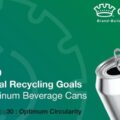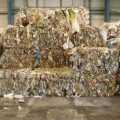The U.S. aluminum beverage can manufacturing industry continues to see unprecedented demand for this environmentally friendly packaging. Most of the new beverages that have been introduced in recent years have been packaged in aluminum cans. The aluminum beverage can has captured market share in beer, wine, kombucha, mineral water, ready-to-go cocktails, still waters and other emerging beverage categories. Mundolatas interviews Robert Budway, president of the Can Manufacturers Institute.
-What is the reason for this significant increase in the demand for aluminum cans in the U.S.?
Most new beverages are coming to market in aluminum cans and long-time customers are abandoning plastic bottles and other packaging substrates for aluminum cans due to environmental concerns. These beverage companies are enjoying the many benefits of the aluminum can, which has the highest recycling rate among all beverage containers.
-Does the U.S. aluminum beverage can industry plan to reach new heights in recycling levels when it announced earlier this year a 70% recycling rate target for 2030?
These new targets will improve the circularity of the aluminum beverage can, while demonstrating to beverage companies and consumers the industry’s dedication to ensuring that the aluminum beverage can remains the most sustainable package on the market.
-The recycling rate for aluminum beverage cans was 45% in 2020, and the industry aims to achieve even higher recycling rates after 2030, with a rate of 80% in 2040 and over 90% in 2050. Are the forecasts ambitious?
CMI members are committed to seeing more aluminum beverage cans complete the circular journey to new cans. In the United States, about 90,000 aluminum cans are recycled every minute, and 93% of them go from the recycling garbage can to the store shelf as a new can in as little as 60 days. This high level of can-to-can recycling has resulted in the aluminum beverage can having an industry-leading average recycled content of 73%. Increasing the recycled content of the average can reduces its carbon footprint, as manufacturing an aluminum beverage can from recycled material results in more than 90% less greenhouse gas emissions than manufacturing the container from primary material.
-The vast majority of Americans embrace recycling as a simple way to help the environment and live more sustainably. Would most be horrified by the sheer number of aluminum cans that end up in landfills each year?
The continued high demand for aluminum beverage cans necessitates the industry’s vision to increase the recycling of used beverage cans (UBC). Increased UBC recycling would improve the resilience of the domestic aluminum supply chain that is incorporated into new cans.
The aluminum beverage can starts from a position of strength. This metal container was designed to be the primary container for recycling, and the can industry has invested billions of dollars to get cans recycled in the United States at scale with existing infrastructure.
CMI’s approach to achieving its recycling rate targets will be to change consumer behavior through activities in four pillars of action:
Catalyze the approval and implementation of well-designed repository systems at the state and federal level.
2. Increase and improve domestic and out-of-home recycling.
Ensure that more cans are correctly sorted at the recycling centers.
4. Increase consumer understanding of the importance of aluminum can recycling and the possibility of collecting and selling used beverage cans for cash.
-What makes a deposit system strong?
As indicated in the first pillar, CMI is a strong advocate of a well-designed repository system. Policymakers across the United States are considering legislation to improve recycling rates, shift recycling costs from taxpayers to consumer goods companies, and create new end markets or improve struggling ones. As Congress and state legislatures consider possible measures, WCC believes that governments should encourage the collection and recycling of higher-value materials, such as aluminum, to create a healthy recycling system. In addition, each package should pay its own recycling cost; packages with lower intrinsic values that do not bear their own recycling cost should be levied a fee to fund collection and market development.
The aluminum beverage can industry has made great strides to ensure that more returned cans are properly sorted at recycling centers. Last year, thanks to funding from Ardagh Metal Packaging and Crown Holdings in collaboration with The Recycling Partnership, five grants were awarded to install new equipment that will collectively recycle an additional 71 million aluminum cans each year. The impact of these millions of recycled aluminum beverage cans will mean more than $1.15 million in revenue for the U.S. recycling system.
The environmental and economic benefits of increased aluminum beverage can recycling are staggering. If the recycling rate for aluminum beverage cans had been 70% in 2020, instead of 45%, about 25.6 billion more cans would have been recycled, generating more than $400 million in revenue for the U.S. recycling system and providing energy savings that could power more than one million U.S. households for an entire year.
-What are the expectations for maintaining the current strong demand?
We expect strong demand to continue for many years, as can makers are investing considerable capital in additional capacity to increase supply. We continue to see more and more beverages choosing cans as their packaging. We expect this to increase as other types of packaging face sustainability and performance hurdles that aluminum cans do not face. We will also continue to invest in activities that ensure that the aluminum can makes that circular journey through the recycling system to become a new can.













0 Comments